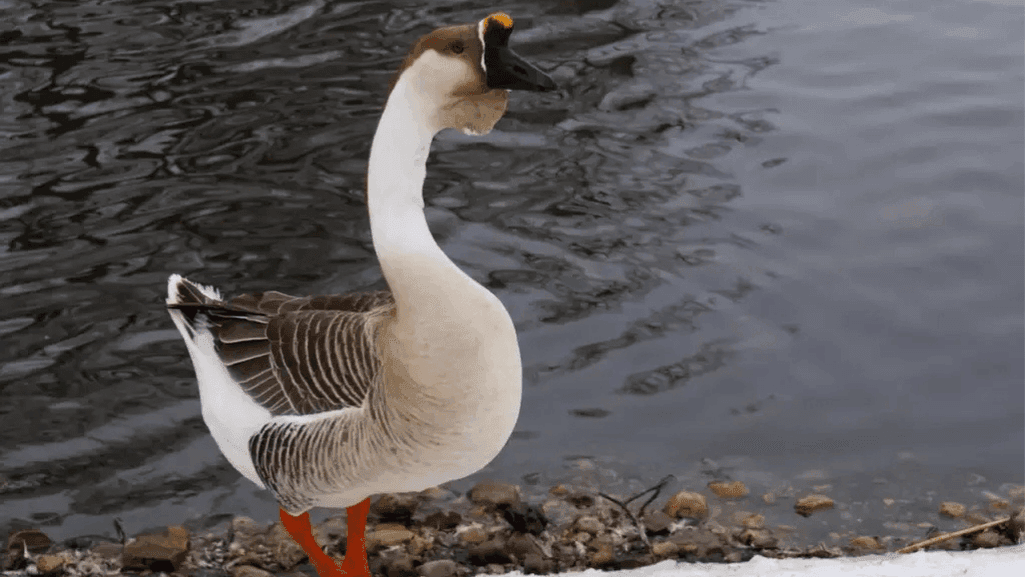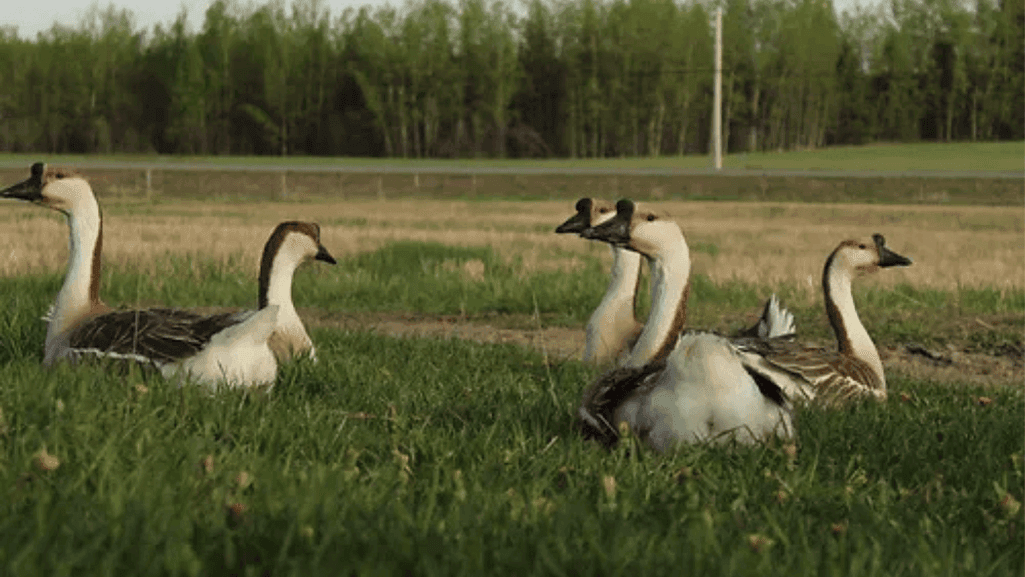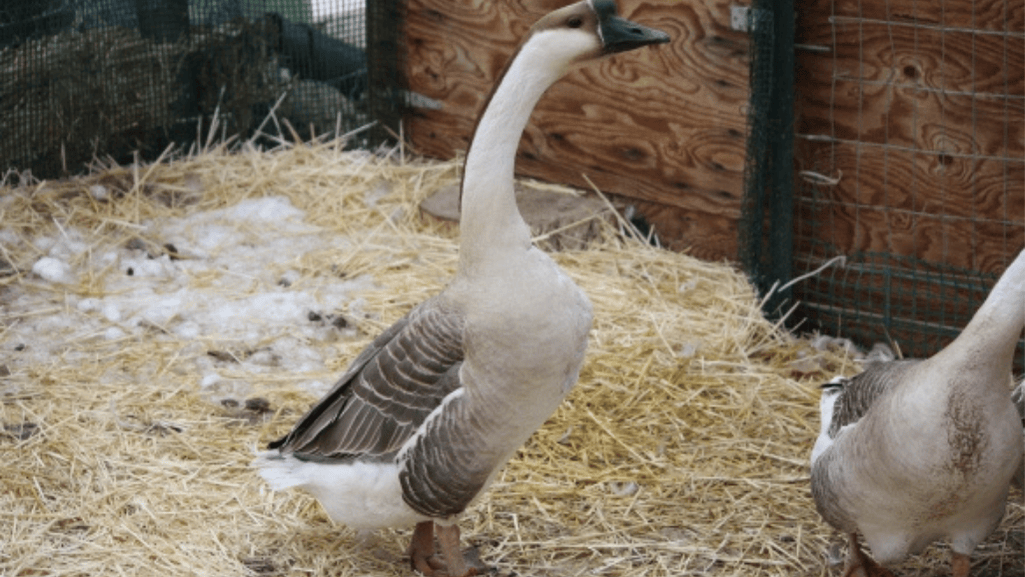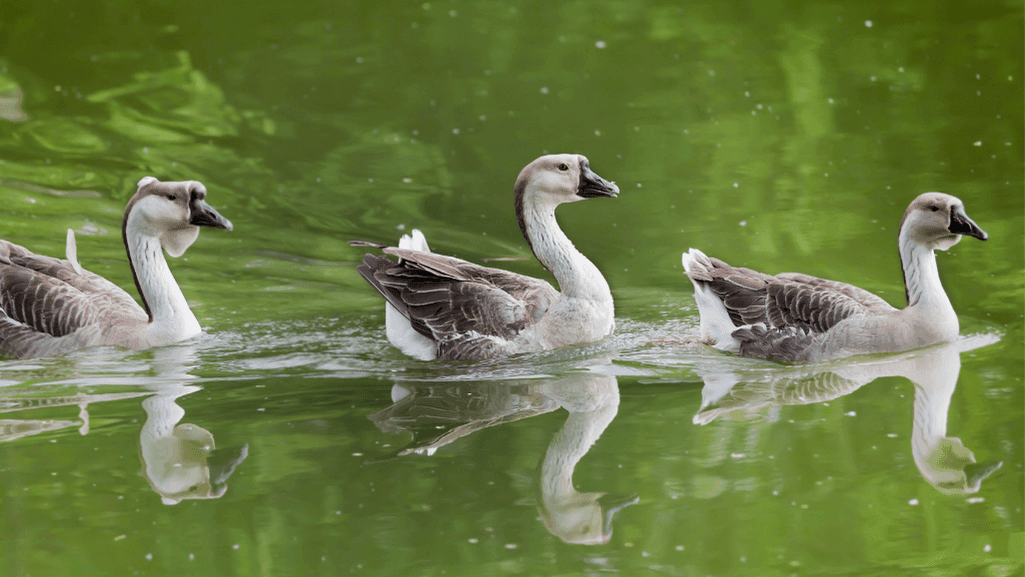The Chinese goose is a special breed that looks like a swan. It comes in white and brown, both with bright orange feet. The white one has an orange bill and forehead knob, while the brown one has a black bill and knob.
These birds have a long history in North America. George Washington even got them as a gift for his Mount Vernon estate.
Chinese geese are great for farming because they lay lots of eggs. They can lay up to twice as many eggs as other geese. The white ganders weigh 12 to 15 pounds, and the females weigh about 10 pounds.
They are also good to eat because their meat is lean and not greasy. This makes them popular in Chinese dishes and cuisine.
Chinese geese start laying eggs at about seven months old. They can start in the spring if they grow up over winter. It’s best to keep four to six geese with one gander for good flock dynamics and female health.
It’s important to feed goslings high protein starter feed and fresh grass. This helps them grow well. By giving them a safe place to live and handling them often, they become tame and relaxed.
If you want to learn more about waterfowl, checking out black and white geese can be interesting. It gives insights into these amazing birds’ lives.
Key Takeaways
- Chinese geese are known for their swan-like appearance and vibrant orange feet, with two varieties: white and brown.
- They are exceptional egg layers, producing up to twice as many eggs as other goose breeds during spring to autumn.
- Chinese geese are valued for their lean, less greasy meat, making them a popular choice in traditional Chinese dishes and cuisine.
- Proper care and management of goslings, including a high protein diet and regular socialization, are essential for their development.
- Maintaining an appropriate ratio of geese to ganders helps ensure optimal flock dynamics and female health.
Overview of Chinese Goose Characteristics
The Chinese goose comes from the Asian wild Swan goose. They have been loved in North America for centuries. These geese are known for their looks and lively nature. They are popular for both beauty and usefulness.
Origin and History
Chinese geese first came to America in 1788. George Washington got a pair of white Chinese geese and two Chinese pigs. These geese are valued for their looks, alertness, and ability to eat grass.
They are used to clear crops like cotton and orchards. This makes them great for weeding.
Physical Features
Chinese geese have a sleek body and a long, slender bill. They have a big, round knob on their forehead. They come in brown and white.
The white ones have pure white feathers, blue eyes, and bright orange feet and bills. The brown ones have a rich brown and fawn color. They have a dark neck stripe. Males weigh about 5 kg, and females weigh about 4 kg.
Temperament and Behavior
Chinese geese are very talkative. They make great watchdogs, alerting owners to strangers. They are also good at finding and eating weeds.
They are useful in many ways, like laying eggs and guarding. Their lively nature and fun antics make them a favorite among goose lovers and smallholding owners.
Nutritional Needs and Feeding
Chinese geese, also known as luohongzhi, need a balanced diet to stay healthy. They are great at controlling algae and weeds in ponds. Knowing what to feed them and when is important for their well-being.
Recommended Diet
Chinese geese love to eat various grasses, clover, and alfalfa. They also enjoy seed heads, wheat, maize, barley, and beans. Insects and berries are a small part of their diet.
When grass is scarce, they need about 200g of food daily. This can include wheat, dried poultry pellets, and a little bread as treats. Goslings need high-protein starter feed and fresh grass if possible.
It’s important to give them safe food options. They might try to eat certain bedding. Feeding them grass clippings and garden weeds from a young age helps them learn to weed effectively.
Feeding Schedule
Wild geese spend half their day eating. Domestic geese, being heavier, need a regular feeding schedule. In the fall, they need about 1 cup of supplemental feed per day.
In winter, they eat less as they conserve energy. A winter feeding plan includes up to 6 quarts of feed daily (½ to 1 cup per goose per day).
Geese are used as natural lawn mowers in environmentally friendly practices, helping control grass growth. They can also be employed in organic farming systems to eliminate broadleaf weeds and perennial grasses.
Special Dietary Considerations
Bread is a favorite treat but lacks nutrients. It can cause malnourishment if given too much. Feeding them wheat and pellets can increase egg production during breeding season.
They also need clean water for digestion and cleaning their eyes, nostrils, and beaks.
Introduce geese to wildflower meadows after mid-February. Use up to two geese per acre. Provide hay in winter months, even in snowy areas. Remember, a balanced diet and proper feeding schedule are key to raising healthy and content Chinese geese, whether you’re raising them for their beauty or as a sustainable alternative to roasted fowl.
Housing and Environment
Keeping Chinese geese safe and happy is key. They need a good home, space, and protection from predators. This ensures they do well in their surroundings.
Ideal Living Conditions
Chinese geese like a mix of indoor and outdoor spaces. Their shelter should be at least 8′ x 10′ to give each bird 6 square feet. The Global Federation of Animal Sanctuaries suggests 6 sq. ft. of floor space per bird indoors.
Outdoor areas need at least 16 sq. ft. of dry ground per bird. For bigger birds or those with mobility issues, concrete floors with traction are best.
Space Requirements
Chinese geese also need lots of room outside to roam and eat grass. They eat a lot of grass, up to 70% of their diet. A 20×40 foot pen is good for three geese.
In smaller yards, you might need to fence off areas to stop them from damaging plants while foraging.
Geese don’t need roosts or nesting boxes. They like to nest on the ground in quiet spots. They use hay or leaves to keep their eggs safe and private.
Protection from Predators
Keeping Chinese geese safe from predators is very important. Use ¼ to ½ inch galvanized hardware cloth to cover openings and keep out weasels and raccoons. Check wooden structures for damage and add extra protection like sheet metal.
Rats are a big threat, so keep food in sealed metal bins. Use galvanized hardware cloth to keep rodents out. In insulated walls, put sheet insulation between layers of hardware cloth to block access.
By making sure their environment is safe and spacious, Chinese geese can stay healthy. They become a beloved part of many homes and are even used in traditional Chinese dishes.
Breeding and Reproduction
Chinese geese are known for laying many eggs, making them popular among goose lovers. They start laying eggs around seven months old or in spring if they mature in winter. Like most geese, they may go broody and hatch eggs successfully.
To ensure breeding success and keep the flock healthy, a proper gender ratio is key. A ratio of four to six geese per gander is best to avoid fights and keep females healthy. Chinese geese are smaller, with males weighing 4.5-5.4 kg and females 3.6-4.5 kg. They are prolific layers, producing 50-60 eggs per season, sometimes up to 100 eggs.
Mating Behavior
Chinese geese have unique mating behavior. Ganders do an elaborate courtship dance to attract mates. Once paired, they stay together for life. Geese should be at least one year old before mating, with some breeders waiting until they are two years old for better breeding.
The Chinese goose is used to make the peking duck, a festive dish enjoyed worldwide. Their small size and early maturity make them ideal for cross-breeding with ducks.
Nesting Practices
Chinese geese are devoted parents. The female chooses a quiet spot for the nest, lining it with soft materials. She incubates the eggs for 28-30 days, rarely leaving the nest.
Did you know that Chinese geese are classified as a “watch” breed by the Livestock Conservancy due to their endangered status? In 2002, the United Kingdom reported a population of only 150-1000 Chinese geese.
Caring for Goslings
After hatching, goslings need special care. They need a safe, warm place and clean water. Use a poultry waterer to prevent splashing and chilling. A heat lamp is essential for the right temperature.
As they grow, introduce them to specialized waterfowl feed, fresh grass, and vegetables. Proper nutrition is vital for their growth. With the right care, Chinese goose breeders can raise healthy, productive birds.
Health and Maintenance
Chinese geese are tough but need care to stay healthy. Knowing common health problems helps keep them well. Their knobs can freeze in cold weather, so they need shelter.
Preventive care is vital for your geese. Regular health checks and a clean home are key. They need grit and sand for digestion. A good diet and fresh water are also important.
Watch for illness signs in your geese. A sick goose may droop or lose appetite. If you see these, get vet help fast. This way, you can enjoy your geese for a long time, like the Cayuga ducks.











